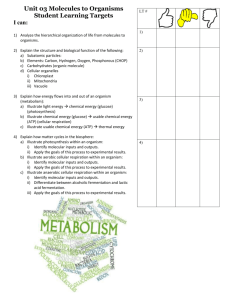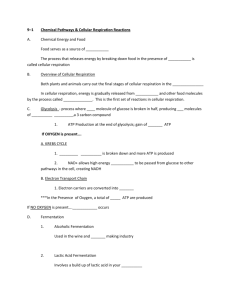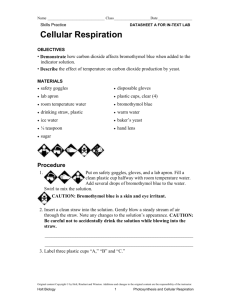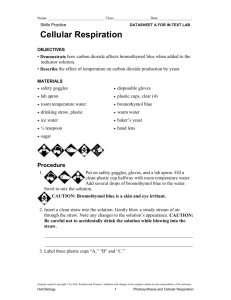Cellular Respiration Lab
advertisement
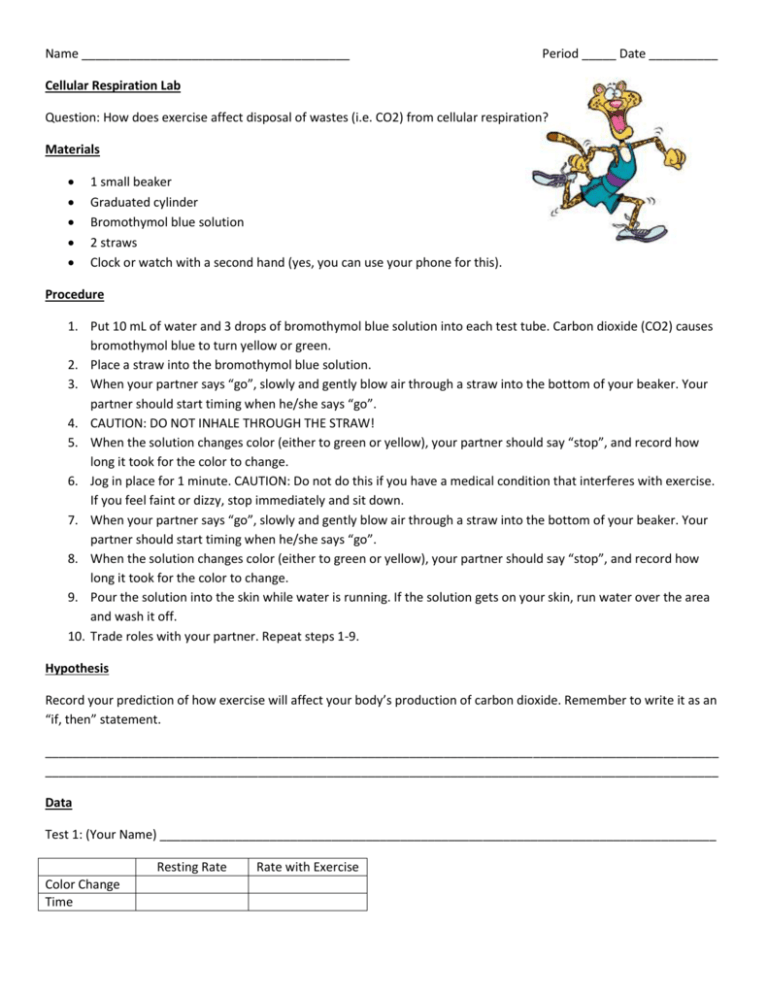
Name _______________________________________ Period _____ Date __________ Cellular Respiration Lab Question: How does exercise affect disposal of wastes (i.e. CO2) from cellular respiration? Materials 1 small beaker Graduated cylinder Bromothymol blue solution 2 straws Clock or watch with a second hand (yes, you can use your phone for this). Procedure 1. Put 10 mL of water and 3 drops of bromothymol blue solution into each test tube. Carbon dioxide (CO2) causes bromothymol blue to turn yellow or green. 2. Place a straw into the bromothymol blue solution. 3. When your partner says “go”, slowly and gently blow air through a straw into the bottom of your beaker. Your partner should start timing when he/she says “go”. 4. CAUTION: DO NOT INHALE THROUGH THE STRAW! 5. When the solution changes color (either to green or yellow), your partner should say “stop”, and record how long it took for the color to change. 6. Jog in place for 1 minute. CAUTION: Do not do this if you have a medical condition that interferes with exercise. If you feel faint or dizzy, stop immediately and sit down. 7. When your partner says “go”, slowly and gently blow air through a straw into the bottom of your beaker. Your partner should start timing when he/she says “go”. 8. When the solution changes color (either to green or yellow), your partner should say “stop”, and record how long it took for the color to change. 9. Pour the solution into the skin while water is running. If the solution gets on your skin, run water over the area and wash it off. 10. Trade roles with your partner. Repeat steps 1-9. Hypothesis Record your prediction of how exercise will affect your body’s production of carbon dioxide. Remember to write it as an “if, then” statement. __________________________________________________________________________________________________ __________________________________________________________________________________________________ Data Test 1: (Your Name) _________________________________________________________________________________ Resting Rate Color Change Time Rate with Exercise Test 2: (Your partners name) __________________________________________________________________________ Resting Rate Rate with Exercise Color Change Time Graph your results Analysis: 1. Explain the data. ___________________________________________________________________________________________ ___________________________________________________________________________________________ 2. What was the dependent variable? ___________________________________________________________________________________________ ___________________________________________________________________________________________ 3. What was the independent variable? ___________________________________________________________________________________________ ___________________________________________________________________________________________ 4. What was the control? Did you have one? ___________________________________________________________________________________________ ___________________________________________________________________________________________ 5. What were the constants? ___________________________________________________________________________________________ ___________________________________________________________________________________________ Conclusion: 1. Was your hypothesis supported? Why or why not? ___________________________________________________________________________________________ ___________________________________________________________________________________________ 2. How did exercise affect the time for the solution to change color? ___________________________________________________________________________________________ ___________________________________________________________________________________________ 3. What processes in your body produces carbon dioxide? ___________________________________________________________________________________________ ___________________________________________________________________________________________ 4. Did you make any mistakes that could be corrected next time? ___________________________________________________________________________________________ ___________________________________________________________________________________________ 5. What else would you want to know about this topic? REINFORCEMENT : Fill in the chart and answer the following questions. WORD BANK 1 ATP 2 ATP 36 ATP 4 NADH 1 FADH Electron transport chain Mitochondrion Cytoplasm Fermentation Glycolysis Glucose Pyruvate Lactic acid Kreb's Cycle Photosynthesis Cellular Respiration Organelle for process Reactants CO2 + H2O Electron Transport Chain (located) Cycle of Chemical Reactions Calvin cycle (does what?) Krebs cycle (does what?) Products 1. What types of carbon-based molecules are most often broken down to make ATP? Explain how ATP production differs depending on the type of carbon-based molecule that is broken down. 2. How does glycolysis contribute to the overall process of cellular respiration? 3. Write the chemical equation for cellular respiration and explain what it represents. 4. What is the function of the Krebs cycle? In your answer, describe the products of the Krebs cycle and what happens to them. 5. Explain the function of the electron transport chain in cellular respiration. Why is oxygen needed for the electron transport chain? 6. Fermentation does not produce ATP. Why is fermentation such an important process in cells? 7. How is alcoholic fermentation similar to lactic acid fermentation? How is it different? 8. In what organelle does the process of cellular respiration take place? 9. Do animals undergo cellular respiration? Do plants? Why/why not?








